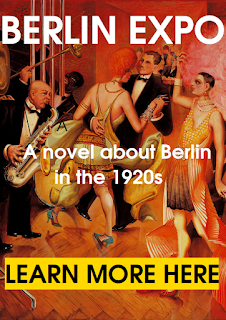 |
| Romanisches Café |
Jeanne Mammen’s
name is not well-known, except among art connaisseurs. Yet her
production was rich and varied.
She was born in Germany in 1890, but her family moved to Paris where she studied art, not only in the French capital but also in Brussels. In 1914, she returned to Germany and, in 1919, moved into a former photographic studio at Kurfürstendamm 29 with her sister Marie Louise, who also painted. The apartment consisted of two small rooms with no electric light and no telephone. “Artists do not need those things,” the landlord told her. In the 1920s the Kurfürstendamm was Berlin’s main thoroughfare, and the studio was located on the fourth-floor of a large apartment building, with the back overlooking the courtyard with trees and birds singing. This is where Jeanne lived until her death in 1976.
She was born in Germany in 1890, but her family moved to Paris where she studied art, not only in the French capital but also in Brussels. In 1914, she returned to Germany and, in 1919, moved into a former photographic studio at Kurfürstendamm 29 with her sister Marie Louise, who also painted. The apartment consisted of two small rooms with no electric light and no telephone. “Artists do not need those things,” the landlord told her. In the 1920s the Kurfürstendamm was Berlin’s main thoroughfare, and the studio was located on the fourth-floor of a large apartment building, with the back overlooking the courtyard with trees and birds singing. This is where Jeanne lived until her death in 1976.
During her lifetime,
she gained a reputation as a chronicler of life in Berlin, supporting
herself by designing film posters for the UFA studios and selling
illustrations to fashion and satirical magazines, including
Simplicissimus, Der Junggeselle, Uhu and Ulk. She had always her
sketchbook at hand, to capturiethe atmosphere in cafes, bars and on
the streets.
 |
| Café Kranzler 1929 |
 | |
| Café Nollendorf 1931 |
In 1929, Kurt
Tucholsky, editor of the intellectual review "Die Weltbühne",
expressed his admiration for her: "Your figures are clear cut
with a clean feel, they are gracious yet austere, and they literally
jump at you out of the paper." Her graphic work from this era
might be likened to the new objectivity of Otto Dix or George Grosz,
but whereas their works is often critical and satirical, Mammen’s
drawings and watercolours are more empathetic and, some say,
feminine.
She survived the
nazi years with the help of friends and mini-commissions. She could
have go into exile as many others, but refused to start afresh once
more in a foreign country. Instead, she lived the life of a recluse,
working by candlelight and scarcely leaving her studio for days at a
time.
She drew the ideal
modern women of the 20s: the glamorous vamp, the diva, the flapper.
She portrayed the bustling metropolis that Berlin was in the 20s,
with its cabarets, theatres, and a hectic lesbian subculture of
“ladies’ clubs”.


No comments:
Post a Comment